
MAY CONTAIN NUTS

Search Shorpy
SHORPY ART

Framed or unframed, desk size to sofa size, printed by us in Arizona and Alabama since 2007. Explore now.
Join and Share
Ad-Free Shorpy
Shorpy is funded by you. Patreon contributors get an ad-free experience.
Learn more.

Recent comments
- Party of Eight?
- Good choice
- Recent view
- Hudson’s Big Store
- Say what??
- Grapes?!
- Just a Great photograph.
- A Beautiful Moment
- Such joy
- Bethune-Cookman University today
- Yellow sky at morning
- Side Winder
- Air Quality?
- Sojourner Truth riot
- None were so blind(ed)
- The less famous sister
- Good ol' days?
- Rise and Fall
- Goo Goo Ga Joob
- Ticket Retention
- Not the only one
- Vagaries of War
- Killed by Amtrak
- Back to the Future
- Wanted --
- If you can't stand the light
- Centralized Traffic Control, I believe
- What's really happening
- Heckuva remote control!
- Sometimes — Things Go Bump!
Member Photos
The Shorpy
Print Emporium
Print Emporium
Search Shorpy
Search results -- 30 results per page
- Wall Street: 1911
- Wall Street east from Nassau Street, 1911. View full size. Irving Underhill.
15 flagpoles And only two ... Posted by Dave - 09/07/2011 - 8:07pm -
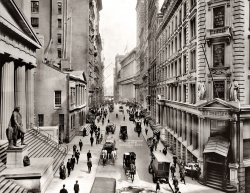
- Meeting Street: 1911
- Charleston, South Carolina, circa 1911. "Meeting Street from St. Michael's Church." Our second installment of ... building, a Bearcat or a Raceabout? If we're sure of the 1911 date of the photo I guess it must be a Mercer, as I don't think the ... Posted by Dave - 05/01/2014 - 8:31am -
![Meeting Street: 1911 Charleston, South Carolina, circa 1911. "Meeting Street from St. Michael's Church." Our second installment of this multi-part panorama, with a nice view of the Fireproof Building and its Doric portico. 8x10 glass negative. View full size.
Six Degrees of Roadster SeparationThe unique drop axle on the front of that roadster eliminates both the Mercer and the Stutz, and instead points to the Empire 20. One trade journal singled it out for comment saying, "The front axle is one of exceptionally strong construction. The size of the steering knuckles would do credit to a car twice its weight."
This Empire looks to be a 1910 and the two bucket seats make it a Model B, rather than the Model A which had a two-person bench seat up front, and a mother-in-law seat mounted in back. Introduced in 1909 by the same syndicate that built the Indianapolis Motor Speedway, the diminutive Empire 20—known as The Little Aristocrat—was the first to circle the Indy track after it was repaved in brick.
Still, there is a reason that moTthediesel thought of the yet-to-be built Stutz when seeing this car—Harry Stutz was the designer and factory manager for the Empire Motor Car Company at this time, having just left a similar position at Marion Motor Car Company. While at Marion he helped design their large roadster, the Marion Bobcat and raced the product as well. Before his stint at Marion, he designed the very first conventional-chassis car for the American Motor Car Company in their pre-American Underslung days.
After starting his own company in 1912, he brought out the Stutz Bearcat, with a name styled after the Marion, a body style evolved from both the Marion and the Empire, and a size that fit perfectly right in-between the two. American, Marion, Empire, Stutz—Indianapolis companies all. As for the upstart New Jersey-built Mercer, they were the main competition for Stutz both on and off the track.
Fireproof BuildingProminently shown in the right foreground is the County Records Building, better known as the "Fireproof Building," designed by native Charlestonian Robert Mills and built 1821-1827. The building acquired its nickname because the architect tried mightily to eliminate wood from every possible part of the structure, including the window frames and the floor construction. Only the roof has wooden members. Mills later moved his office to Washington, where he designed such important buildings as the Washington Monument and the Treasury Building.
Stutz or Mercer?Which is it parked across the street from the Records building, a Bearcat or a Raceabout? If we're sure of the 1911 date of the photo I guess it must be a Mercer, as I don't think the Bearcat was available before 1912.
Either way, just about the hottest performance cars available at that time.
Look, over there!Couple of things. I can't quite figure out the statue just under St. John's that's pointing down the street. How does one zoom into a photo, even after it's been enlarged? I've always wondered. Also, I don't believe I've ever seen a cupola roof used for advertising as it seems is done here. I think it says "bar" at the bottom, but here again I can't zoom.
[The "St. John" sign is on the roof of the white building in the foreground block. The "statue," here magnified from the full-size LOC scan, appears to be a kind of store sign. -tterrace]
Trade Statue corner of Queen and MeetingI am a member of a historical group in Charleston SC. We are trying to determine what the statue pointing down Queen St is. It appears to be on a base as cigar Indians trade statues used.
(The Gallery, Charleston, DPC)](https://www.shorpy.com/files/images/SHORPY_4a10448a.thumbnail.jpg)
- Going Up: 1911
- Detroit, Michigan, circa 1911. "Dime Savings Bank building under construction." 8x10 inch dry plate ... Posted by Dave - 08/02/2012 - 10:05pm -
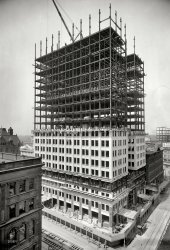
- Our Gang: 1911
- ... Orchard Mfg. Co. Indian Orchard, Massachusetts. September 1911. View full size.
Where's Darla and Buckwheat? They seem to ... Posted by Dave - 07/27/2012 - 9:56am -
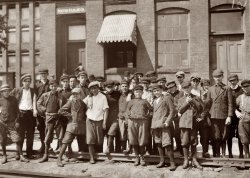
- Game Day: 1911
- ... Washington, D.C. "Football -- Georgetown University game, 1911." CI years before Super Bowl XLVI. Harris & Ewing glass negative. ... Posted by Dave - 06/14/2013 - 7:35pm -
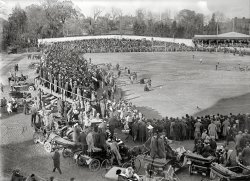
- Serafino and Chub: 1911
- January 1911. "Serafino driving Chub, his mule. Shaft #7, Pennsylvania Coal Company ... Posted by Dave - 08/14/2009 - 8:55pm -
![Serafino and Chub: 1911 January 1911. "Serafino driving Chub, his mule. Shaft #7, Pennsylvania Coal Company mine at South Pittston." Bright spots are open flames of lamps on the boys' hats. Photograph by Lewis Wickes Hine. View full size.
Serafino & ChubThis photo is so surreal. Serafino's eyes are amazingly creepy! Looming up from the darkness.
Sam KeysIt says Samuel Keys up the left beam.
[Funny. Doesn't sound Greek. But yes. I think you're right! - Dave]
S.K.While delta would be more sexy, I still think that if a girl was working down there, it'd read "S [heart] K [heart]". :)
AhhhI think this is the most terrifying picture.
Also, I think those are initials: S.K. You weren't being sarcastic, were you?
[It's S-delta-K-delta. With the name "Sami" underneath. Looks Eastern European/Bulgarian/Serbian/Turkish. - Dave]
Mule LifespanI wonder how long a mule lasted in a coal mine?
Ghostly Images of a MineAmazing how this photograph seemed to capture a gathering of ghostly figures at a dark, almost misty looking part of the mine.
(The Gallery, Horses, Lewis Hine, Mining)](https://www.shorpy.com/files/images/01100u.thumbnail.jpg)
- Fair Warning: 1911
- ... We missed it, and we regret it.
Fall 1911. "The village street -- Lee, Massachusetts." Our title comes from the ... Posted by Dave - 11/10/2019 - 2:02pm -
![Fair Warning: 1911 We missed it, and we regret it.
Fall 1911. "The village street -- Lee, Massachusetts." Our title comes from the handbill posted at left. 8x10 inch dry plate glass negative, Detroit Publishing Company. View full size.
It's still thereWish I knew how to embed an interactive image like the smart people do!
Open Google Maps.
Go to the Street View image you'd like to embed.
In the top left, click Menu (the three dots).
Click Share or Embed Map.
Click Embed Map.
To the left of the text box, pick the size you want by clicking the Down arrow.
Copy the text in the box. Paste it into the HTML of your website.
Great Barrington FairDon't miss it, or else.
The bank is gone.. but the Municipal building remains along with some of the others.
I Got There Before GoogleLong before Google Earth came around I had a similar photo of downtown Lee, Mass. in my historic trolley photo collection that I thought had been taken about 1902 when the trolley line first opened to Great Barrington.
During a chance visit to Lee in 1982 I snapped the attached photo and was pleasantly surprised when I returned home and found that I had nailed the photo angle pretty accurately.
In retrospect, based on the size of the trees, I'm guessing my photo was taken a few months after the Shorpy image.
First read the comments ...before you intend to comment. [Or, click the links in the caption. - Dave]
Below, a postcard of the Great Barrington Fair racetrack & judges' stand.
Lee factoidFrom the Wikipedia article on the town: "Arlo Guthrie's court appearance before the blind judge and his seeing-eye dog for dumping garbage as described in the song 'Alice's Restaurant' took place in the courtroom at the Lee Town Hall."
All Those ElmsOne of the reason these turn-of-the-century photos of Northeastern towns are so appealing is the presence of elm trees, which make that cathedral arch shape over the street. Even when none of the buildings are removed, the trees are now inevitably gone, as a result of the decimation caused by Dutch elm disease. Here's a picture from the Wikipedia Elm page showing an example from Salem, Mass., in 1910.
(The Gallery, DPC, Small Towns)](https://www.shorpy.com/files/images/SHORPY-4a24268a.thumbnail.jpg)
- Bessie Hicks: 1911
- June 1911. "A Suggestion for Dependent Widows. Mrs. Bessie Hicks, a widow in the ... Posted by Dave - 09/08/2011 - 6:22pm -
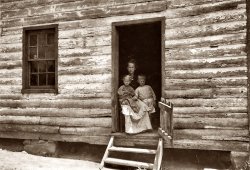
- Breaker Boys: 1911
- January 1911. "Group of boys working in No. 9 Breaker. Pennsylvania Coal Co., ... Posted by Dave - 06/24/2021 - 11:20am -
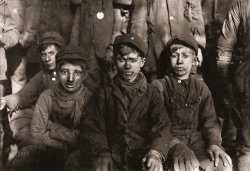
- Columbus in Chicago: 1911
- Chicago circa 1911. "Steamer Christopher Columbus ." 8x10 inch dry plate glass negative, ... Posted by Dave - 10/12/2015 - 8:22pm -
![Columbus in Chicago: 1911 Chicago circa 1911. "Steamer Christopher Columbus." 8x10 inch dry plate glass negative, Detroit Publishing Company. View full size.
The One And OnlyAlthough several Steamships of the "Whaleback" style were built, The Christopher Columbus was the ONLY Passenger steamer of that design. Constructed in 1892-1893, it was exhibited at the Columbian Exposition in Chicago, and eventually scrapped in 1936.
What's Happening?Any idea what's going on here? The Columbus is under tow at both ends (apparently moving sideways). I don't imagine that was routine.
Stability testingWhen in 1915 the SS Eastland capsized in while docked in the Chicago River with the loss of over 800 lives, officials subsequently ordered many passenger ships to undergo stability testing, which the Columbus passed easily. Even with 7,500 sandbags (simulating passengers) piled on one side, and tugboats pulling in that direction, she listed only 12 degrees. Below is a photo of the testing.
I'm curious tooCould it be that the tug on the stern line is turning the ship while the tug on the bow line is holding in place until the ship is headed in the correct position to be towed to the dock.
Realistic sandbagsIf they are doing the stability testing in the photo those sandbags along the rails sure look like passengers to me.
[No one has said the Shorpy photo is of the stability test. -tterrace]
Tugboat practiceForty years ago I worked at Grangemouth Docks and often saw tugs doing their thing. It's a long time ago and few clear memories remain, but I've always thought it quite normal for tugs to work in pairs, one ahead and one astern of the larger vessel. The one ahead provides the main towing force while the other can act as a brake, and either/both can swing the ship around as required. Overall, two tugs allow much more control than one.
Swinging the shipI think the tugs are simply turning the ship around. It is usual practice to use two tugs, one on the bow and the other on the stern to swing a ship in confined waters. Malted Falcon mentions that the ship was tested for stability after the Eastland disaster but I don't think that is what is happening in this picture. The tug with the bow line is not the same one in the picture of the test and I don't think they would do the stability test with all those people on board.
[No one has said the Shorpy photo is of the stability test. -tterrace]
(The Gallery, Boats & Bridges, Chicago, DPC)](https://www.shorpy.com/files/images/SHORPY-4a16156a.thumbnail.jpg)
- Happy Face: 1911
- August 1911. New Bedford, Massachusetts. "A group of workers in the Butler Mills. Kate ... Posted by Dave - 08/26/2009 - 3:18am -
![Happy Face: 1911 August 1911. New Bedford, Massachusetts. "A group of workers in the Butler Mills. Kate McCormick, 10 Cleveland Street, the smallest girl in the picture, apparently 13 years old. The happy faces appear only when the photo is being taken." Photo and caption by Lewis Wickes Hine. View full size.
What's really going on here?According to Hine, they only smile for the birdie, I think he was wrong. These kids smiled because they thought it was fun to have their picture taken. This doesn't diminish the fact that at 13 years their school career was over and that they would work hard the rest of their lives. However we are a nation of optimists. Facing these young people was a World War in which some these boys would surely serve and a depression, that would affect everyone followed by another World War. Yet, we survived, as the strongest, most prosperous and just country ever.
Let me go find a tissue...Dave, are you just trying to make us depressed with all these pictures of dirty, underprivileged, underage workers and children? Because it's working.
[Dirty? Depressing? I don't see that here. - Dave]
Step KidsThey certainly don't look like forced smiles. I love the demeanor of the girl in the middle with her hands on her hips.
Oh the disappointmentThe nigh-palpable disappointment in Mr. Hines' commentary nearly oozes off the screen. Underprivileged kids, working, should be solid gold. And then they go and SMILE! AAAAUGH! Rotten kids.
(The Gallery, Lewis Hine)](https://www.shorpy.com/files/images/02249u.thumbnail.jpg)
- Thanksgiving Maskers: 1911
- November 1911. Before Halloween came into its own as a holiday in this country, there ... Posted by Dave - 12/10/2007 - 6:24pm -
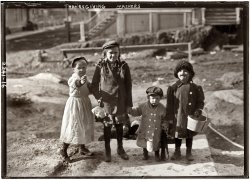
- No. 9 Breaker: 1911
- January 1911. Boys working in the #9 breaker of the Pennsylvania Coal Co. mine at ... Posted by Dave - 12/10/2007 - 3:10pm -
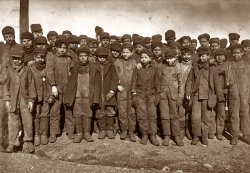
- Colorful Cleveland: 1911
- Cleveland, Ohio, circa 1911. "The Public Square -- Soldiers' and Sailors' Monument." A bustling scene, ... Posted by Dave - 07/30/2012 - 10:25pm -

- Doffed All Summer: 1911
- ... school. Location: Indian Orchard, Massachusetts. September 1911. Photo by Lewis Wickes Hine. In a textile mill, the doffer removes the ... Posted by Dave - 09/07/2011 - 2:35pm -
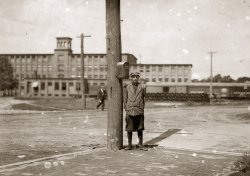
- Les Miserables: 1911
- October 1911. Lowell, Massachusetts. "Pin boys in Les Miserables Alleys. Frank Jarose, ... Posted by Dave - 08/15/2012 - 9:09am -
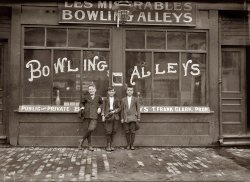
- Magnolia Mills: 1911
- March 1911. Magnolia, Mississippi. "Interior of Magnolia Cotton Mills spinning room. ... Posted by Dave - 06/14/2012 - 11:48am -
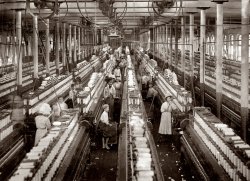
- Oscar Weston: 1911
- June 1911. "Oscar Weston, 1320 Berkley Avenue, South Norfolk. Has been doing 'toting ... Posted by Dave - 08/24/2011 - 1:24pm -
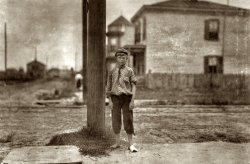
- Hotel Vermont: 1911
- Burlington, Vermont, circa 1911. "Hotel Vermont." Last glimpsed here . 8x10 inch dry plate glass ... railroads. Below, an excerpt from "The Modern Railroad" (1911), and an example of an interline mileage exchange ticket stub. Selling the ... Posted by Dave - 07/27/2018 - 10:06am -
![Hotel Vermont: 1911 Burlington, Vermont, circa 1911. "Hotel Vermont." Last glimpsed here. 8x10 inch dry plate glass negative, Detroit Publishing Company. View full size.
Gift cards, 100 years ago.To the left of the Western Union sign, a small sign that says "Mileages bought and sold" caught my eye. A little research reveals this phrase appearing in newspapers and photos from around 1900 to 1915. I couldn't find a definite explanation, but based on the context of some of those ads, I think it was possible, at that time, to buy a certain number of miles on a particular railroad - sort of like buying a gift card today.
["Mileages" were the coupons in mileage books, which allowed X miles' worth of "interline" travel over multiple railroads. Below, an excerpt from "The Modern Railroad" (1911), and an example of an interline mileage exchange ticket stub. Selling the remaining coupons to a broker before they expire lets the holder avoid a loss on his unused miles. - Dave]
In addition to the railroad selling its tickets there are also railroad passenger traffic organizations, half a dozen or more important ones across the country, which are engaged in selling various forms of railroad transportation. In some cases this takes the shape of a mileage-book which may be honored by fifteen or twenty different lines. The book will perhaps be sold for $25 and will permit of 1,000 miles’ riding at a saving over local fares, if the purchaser comply with its provisions. If he has complied with its provisions within the year’s life of the book, he will be paid $5 rebate upon return of its cover which has given him his riding at two cents a mile. Sometimes these books take the form of “scrip” which is silent upon mileage but which has its strip divided into five-cent portions, sold at wholesale, as it were, at a fraction less than five cents each.
Edit, 31 July 2018: Today I learned, thanks! This also jogged a memory of reading one of those signs on the back of a hotel-room door, and seeing "mileage books" as one of the things you were supposed to deposit in the hotel safe instead of keep in your room.
I'm still not quite sure why mileage books aren't mentioned much in publications after about 1915. I did find a law in New York State, still on the books, that requires railroads with fares between 2 and 3 cents per mile to issue mileage books for no more than 2 cents per mile. Maybe as fares went up, the laws weren't updated, and therefore the railroads were no longer obligated to issue mileage books.
Hotel Vermont? Not with a bit of imagination.I do believe that to be Rick's Cafe with Sidney Greenstreet (Ferrari), wearing his fez hat and just crossing the street to enter as everything magically turns into Vichy-Casablanca of December 1941. Waiting inside, in addition to Rick, are Victor Lazo, Ilsa, Sam, Capt. Renault, Major Strasser and the lovable Carl (Cuddles Sakall). After all, everybody comes to Rick's, though not always for long as Peter (Ugarte) Lorre has already been eliminated.
Academic CoincidenceThe Bowling Academy at left is where Lewis Hine, the man who made Shorpy famous, photographed two pin boys whose work kept them up late on school nights.
http://www.loc.gov/pictures/resource/nclc.03374/
[Coming soon to a website near you! - Dave]
https://www.shorpy.com/node/23650
Loved the awnings back then!Still there! Went to a Brazilian Restaurant on the ground floor a few years back.
(The Gallery, DPC, Horses)](https://www.shorpy.com/files/images/SHORPY-4a25372a.thumbnail.jpg)
- What a Dump: 1911
- November 13, 1911. "New York streets during garbage strike." Note ashcans full of actual ... eliminates Ninth, Third and Second avenues, and even in 1911 the avenues between Eighth and Lexington would have been more commercial ... Posted by Dave - 03/27/2014 - 10:02am -
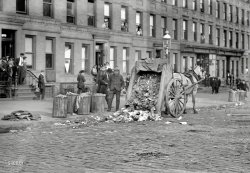
- Let Us Have Peace: 1911
- New York circa 1911. "Grant's Tomb and rubber-neck auto on Riverside Drive." 8x10 inch dry ... Posted by Dave - 01/11/2021 - 3:27pm -
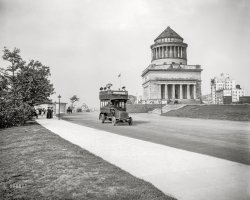
- Postal Boys: 1911
- June 1911. Norfolk, Virginia. "A typical group of Postal Messengers. Smallest on ... Posted by Dave - 08/13/2013 - 3:59pm -
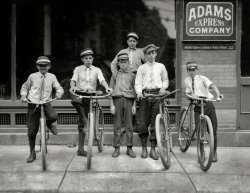
- The Pecans of Wrath: 1911
- December 1911. "3:30 P.M. -- Picking nuts in dirty basement tenement, 143 Hudson Street, ... Posted by Dave - 12/13/2017 - 6:56am -
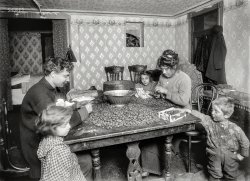
- Indian Orchard Mills: 1911
- September 1911. Group in front of Indian Orchard Mfg. Co. Indian Orchard, Massachusetts. September 1911. View full size. Photo by Lewis Wickes Hine.
(The Gallery, ... Posted by Dave - 12/20/2007 - 3:48am -
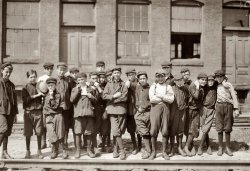
- South Pittston: 1911
- ... Pennsylvania Coal Company's South Pittston mine. January 1911. View full size. Photograph by Lewis Wickes Hine.
Pittston Miners ... Posted by Dave - 08/15/2012 - 9:06am -
![South Pittston: 1911 Shaft No. 6 workers at the Pennsylvania Coal Company's South Pittston mine. January 1911. View full size. Photograph by Lewis Wickes Hine.
Pittston MinersThese photos wowed me because my Granddad, an immigrant, went to work in a Pittston coal mine at the age of 14 as a water boy, and lived in Pittston for 18 years before moving to Utica, New York. He "worked his way up," becoming a miner ... Does anyone know if the Pennsylvania Coal Company had the only coal mine in Pittston at that time? Or were there others? These photos may well have been the very place where my Grandfather started out his life here in the USA. Who knows, one of those kids in the pictures might be him!
[Very interesting! What year was your granddad born? - Dave]
American DreamGranddad was born in 1870 in poverty-stricken southern Italy and came to the USA in 1894 to Youngstown, Ohio, where he stayed only a very short time. He was then brought to Pittston, Pa., by his father, who had immigrated earlier and was working in the coal mine. Granddad started work there at the age of 14 as a water boy, then as a miner as he got older. He saved enough over the next 18-20 years to open a small grocery and then a private bank in Pittston, lending to new immigrants from different countries. Sort of the "American dream" story.
So young, so very young.So young, so very young. Their eyes have no light left, only reflecting. What a world.
(The Gallery, Kids, Lewis Hine, Mining)](https://www.shorpy.com/files/images/01144u.thumbnail.jpg)
- Seventeenth Street: 1911
- Circa 1911, our third selection from the panoramic series "Washington from Washington ... White . The stables were razed in the summer of 1911.
(The Gallery, D.C., DPC) ... Posted by Dave - 04/14/2014 - 12:30pm -
![Seventeenth Street: 1911 Circa 1911, our third selection from the panoramic series "Washington from Washington Monument." Landmarks include, from left, Memorial Continental Hall (headquarters of the Daughters of the American Revolution); the Corcoran Gallery of Art; State, War and Navy Building; and White House West Wingtip. 8x10 inch glass negative, Detroit Publishing Company. View full size.
More LandmarksA tiny sliver of the Pan American Union Building (Paul Cret, architect, 1908-1910) at the extreme lower left margin, and the Octagon House (designed by Dr. William Thornton, 1799-1801), just to the left of the Corcoran Gallery and across New York Avenue.
Constitution Hall?Isn't the name of the Daughters of the American Revolution auditorium Constitution Hall, not Continental Hall? I could be wrong, but I lived in DC for a short time and I seem to remember Constitution Hall.
[Constitution Hall wasn't built until 1929. -tterrace]
WH StablesAlso visible are the White House stables, a portion of which were glimpsed at The President's White. The stables were razed in the summer of 1911.
(The Gallery, D.C., DPC)](https://www.shorpy.com/files/images/SHORPY_4a10393a.thumbnail.jpg)
- The Libertines: 1911
- New York, December 1911. "Mrs. Lucy Libertine and family: Johnnie, 4 years old; Mary, 6 years; ... Posted by Dave - 12/13/2017 - 12:10am -
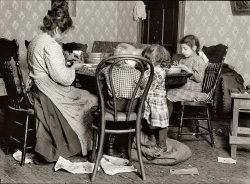
- Bat Nelson: 1911
- Lightweight boxing champ "Bat" Nelson in 1911. After retiring from the ring, Bat (short for Battling; aka the Durable ... Posted by Dave - 08/09/2012 - 5:52am -
![Bat Nelson: 1911 Lightweight boxing champ "Bat" Nelson in 1911. After retiring from the ring, Bat (short for Battling; aka the Durable Dane, born Oscar Nielsen) dabbled in fight promotion and vaudeville. In January 1954, "a pathetic little man of 80 pounds, his mind a complete blank," Bat was committed to the Chicago State Hospital; a month later he was dead of lung cancer at age 71. With 68 wins, 19 draws and 19 losses, Bat once said that although he had "lost several fights," he had never been beaten. 8x10 glass negative, George Grantham Bain Collection. View full size.
The Durable Dane"Bat" was a real brawler, evidently. More here, including great tales and quotes.
Batty NelsonIt also proves you can only take so many hits before your mind quits. Anyone can brag all they want to about how tough they are but it gets you soon enough. How many of his 71 years were spent in a mindless state? I don't see how anyone could call boxing a sport when the goal was to knock someone senseless. If this Extreme Boxing fad that now exists goes any further we'll see even more of it.
[Bat was put under psychiatric observation in 1927 for stealing a fight film and resisting arrest. He was released after doctors at the Psychopathic Hospital found him to be not insane, just "a trifle eccentric." - Dave]
From the New York Times, 2-26-1927:
CHICAGO, Feb. 25 -- Oscar "Battling" Nelson, the famed "Durable Dane" of Hegewisch, Ill., former world lightweight champion and one of pugilism's outstanding characters, tonight is under psychopathic observation, with a charge of grand larceny hanging over him.
The Dane's greatest ring contest -- his battle seventeen years ago in which he lost the championship to Ad Wolgast -- has risen from fight history to plague him. He faces a charge in Butte, Montana, of stealing the motion pictures of that fight and bringing them here.
Nelson has developed numerous idiosyncrasies since his ring days. He often gesticulates with rights and lefts, his posture while talking often becomes a weaving, swaying motion, like a crafty ringman in battle, and he has eccentricities which, his friends say, may be traced to the terrific punishment he took while battering his way to a world title.
When officers went to Nelson's home to serve the warrant the Dane barricaded himself and surrendered only after some discussion.
When Nelson was taken into court to face extradition proceedings today, his unusual demeanor caught the attention of Judge Max Luster, who ordered him under psychopathic examination.
Battling Nelson vs Eddie LangMy great-uncle Eddie Lang fought Battling Nelson for the title in Nelson's last fight before losing his title to Ad Wolgast in about 40 brutal rounds. My grandfather (father's father) and Eddie's brother was in his corner -- he gave Nelson a scrappy fight and was KO'd in the 8th from body blows. The crowd actually cheered my great-uncle on for mixing it up and the papers called him "The Ghetto Captain." He fought the best around, and his brother Ira Lang (under the name Young Sweeney) did as well -- another great-uncle.
(The Gallery, G.G. Bain, Sports)](https://www.shorpy.com/files/images/01716u.thumbnail.jpg)
- Sailor Burke: 1911
- New York, 1911. "Sailor Burke." The Brooklyn-born welterweight champion known to his ... Posted by Dave - 01/26/2015 - 9:52pm -
![Sailor Burke: 1911 New York, 1911. "Sailor Burke." The Brooklyn-born welterweight champion known to his mother as Charles Presser, and someone you wouldn't want to meet in a well-lit alley. 5x7 glass negative, Bain News Service. View full size.
Feel the Pressure of PresserJudging by his muscle tone, he is definitely not one to mess with in any alley.
I remember my dad's boxing days in the RAF when I was growing up and he had a similar stance when we got naughty.
Another twilight zone picture.Something is wrong in this picture, I plainly see an Ipad someone forgot to move out of the picture. (right side resting against the barn.)
You can even see the home button.
[That's the photographer's plate holder. - Dave]
Watch out Lois!Keep some kryptonite handy. He seems to be in the Superman position ready to take the flying leap necessary to become airborne. He even has the (slightly different) curl on his forehead and he doesn't need a cape, leotards or tights. Pretty intimidating.
GobsmackedWell someone should tell "Cholly" to buy a dance belt before getting his picture took. The Sailor demonstrates that his fleet is in harbor and at anchor.
The Great White NopeHe must have been a heckuva fighter because he battled the future heavyweight champ, African-American puncher Jack Johnson, in 1907, despite giving away 20 pounds to his bigger foe. It didn't go well for the Sailor. From the L.A. Herald:
JACK JOHNSON BEATS SAILOR BURKE BEFORE 5000
In Six Rounds Negro Floors Opponent Several Times In Fierce Battle
BRIDGEPORT, Conn., Sept. 12.— Jack Johnson, the colored heavyweight, outfought Sailor Burke before the Liberty Athletic club tonight before 5000 spectators. The flght was of six rounds, and the colored man, who outweighed the sailor, landed some terrific blows, flooring his man several times. Burke weighed 165 and Johnson 185.
(The Gallery, G.G. Bain, Sports)](https://www.shorpy.com/files/images/SHORPY-09786u1.thumbnail.jpg)
- Hotel Vermont: 1911
- Burlington, Vermont, circa 1911. "Hotel Vermont." Now the Vermont House condominiums. 8x10 glass negative, ... Posted by Dave - 02/20/2014 - 1:40pm -
![Hotel Vermont: 1911 Burlington, Vermont, circa 1911. "Hotel Vermont." Now the Vermont House condominiums. 8x10 glass negative, Detroit Publishing Co. View full size.
Still there at Main & St PaulView Larger Map
RoofI wonder what those two ladies are doing up on the roof.
Sidewalk skylights?I used to work in a department store building that had ones like those in front of Hotel Vermont and remember the distinctive sound and shadows of pedestrians passing by above. I always wondered if they had a specific name, or if they were just known as sidewalk skylights. Though there were many old examples in downtown San Diego at that time (early 1960s) I don't think there are any now.
[Sidewalk skylights are among Shorpy's most popular street scene sightings, joining arc lamps, precarious building-ledge people and drug store rubber goods signs. -tterrace]
A pair of fine-feathered friends....... are roosting on the roof.
Look closelyon the long side of the building for the Hotel Vermont sign( paint or brick?) one floor below the iron balcony, it is visble on both google and the original photo.
Ghostly Maidens on the RoofVisitors from the Overlook Hotel maybe?
(The Gallery, Cars, Trucks, Buses, DPC)](https://www.shorpy.com/files/images/SHORPY_4a24282a.thumbnail.jpg)























